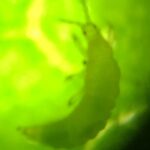I want to bring the DGC together and put some scientific evidence supporting or refuting the hypothesis that powdery mildew is systemic. The definition of systemic is pertaining to or affecting the body as a whole or involves multiple organs. For animals it typically means it has gotten into the blood stream as is able to then infect other parts of the body from within. If we are then applying this to cannabis, if it is said powdery mildew is systemic do we then mean it can infect other parts of the plant from within? All five main genera of powdery mildew of which 900 + species have been identified are obligate pathogens (podosphaera, erysiphe, leveillula, golovinomyces and oidium). Some are host specific and some are opportunist and will attempt to infect a variety of plants. All reproduce through the production of spores (conidia singular or conidiophores for a string of them) we actually see as the “powder” on the leaves. They have specialized cells called haustoria that are food absorbing projection that penetrate the epidermal cells of the plant. They absorb food through this haustoria and use the energy to create new hyphae that grow over the surface producing new conidia that do not require moisture to fruit and infect more tissue. There is also chasmothecia that are small pepper like specks that are formed and can survive without a suitable host. I would have to argue based upon the reproductive nature that only penetrating the epidermal layer of cells and then producing new spores for reproduction would mean the scourge of growing is in fact not systemic at all and can be unlike herpes as some put can be gotten rid of. The problem is that a single spore left after all the treatment in the world will still infect a plant that is not ready to defend itself through disrupting transcription within the pathogen (the typical defense of plants against powdery mildew attacks). I am open to any and all discussion that is science and research based. Peak into the 1000 Fungal Genome Project where we have learned evolutionary relationships through genome comparison of a variety of not only powdery but also downy mildew etc. On another note… with point mutations, deletions etc in the quickly mostly asexual reproduction of powdery could there be species of pm that has become systemic and can somehow move its spores within the plant? I feel like that is the only way PM could be considered systemic. It reproductive bodies have to be able to travel within the tissue of the plant to another spot within the plant like translocation of nutrients in order to be systemic. I would still argue that is highly unlikely and the infection is only in the epidermal layer or even if deeper spores don’t travel through the xylem or phloem with water a nutrients are able to. Thanks for everything from the crew. Hope we can shed some more light on this issue.
Powdery Mildew … Is it really systemic?
by TheProfessor | Oct 26, 2016 | Grower Questions | 10 comments
10 Comments
Submit a Comment Cancel reply
You must be logged in to post a comment.







From what I have read powdery mildew is a fungal pathogen that colonize living plant to acquire nutrients. And my experience of gardening for 20 years is when you see it is already too late. The white mildew is a symptom of the plant having gotten the pathogen 3-7 days prior. That is what led me to say it is systemic. But as the dude says that is just in my none scientific mind speaking. I do still think the only mode of action once you have it is to attack it systemically. I am open to discuss… you think if you could remove all the air born spores and remove all infected area you could remove it completely… theoretically?
I appreciate you joining the discussion. I agree with what you’ve read in that it is a fungal pathogen. I also agree that by the time we see any “powder” the original spore has already reproduced enough times to be seen and has already released other spores into the air to infect other plants. My question is whether the spores that create the new fungal colonies are passed within the plants tissue to another part of the plant? Do plants transport the spores when they are moving water and nutrients? If that is the case then I would say yes PM is systemic. If that is not the case then we should hypothetically be able to remove any infected tissue, rid the room of spores seal it and only allow filtered air in and treat the plant and you should be able to get rid of the PM from mothers or other stock plants. If the spores are being transported within the plants then yeah it is systemic and all we can due is treat the symptoms or use a systemic fungicide as you suggested.
I feel like the reason a systemic works though is not because it attacks spores within the plant but creates an environment that new spores present within the room that land on the plant can’t reproduce.
The main reason I ask this is to figure out if we should just get rid of mothers or stock plants that we see PM on or just keep fighting and spraying like our friend with the 7 day PM spray routine to keep the genetics. Is there a cure for it or will we always have it once we see it? Thanks again for adding to the discussion LongBottomLeaf. Your knowledge is appreciated.
http://www.apsnet.org/edcenter/intropp/pathogengroups/pages/introfungi.aspx
Good Fungus Read That Sites A Lot Of Literature
American Phytopathological Society
This is funny I end up at the same place APS site. Especially when you read the section on powdery mildew. So it is biotrophic which to me means that it is essentially a parasite for plants. But a relationship in which it needs the host to stay alive to draw nutrients but it doesn’t explain its mode of infection just the long strands of “sticky fingers” that can pierce the plants cells and take the nutrients out. So that is why a silica is so effective as a preventative measure because it just cant grab onto the surface of the leaf in spore form. But still nothing further about it being able to go dormant in the plant tissue or accessing the plants water or nutrient stream. Dude mention more talk about this Monday’s show looking forward to it.
I know and it seems we are definitely finding a lot of the same info. I look forward to what they bring us as well on Mondays show. Apparently we need to get funding to do some of our own research because it might not be something that is definitive. I was hoping some other people would join the discussion but maybe after Mondays show it will pick up.
The way it was explained to me:
When a plant gets PM, fungal hyphae penetrate the gaps between the cells of the plant and work their way into the inner tissues of the plant. Once they have penetrated the outer layer of cells, the hyphae can spread throughout the inner tissue of the plant. At this point the fungus becomes pretty much a part of the plant and may even create new spores within the plant. Once its established in the tissue, its in there for good.
Silica strengthens and thickens the plants cell walls, which can make it much more difficult for fungal hyphae to penetrate into the plant. If a fungal spore is unable to dig in and anchor itself to your plant, it wont survive or spread. This is why its so important to have lots of air movement and to use silica, neem and other products that create a layer of protection.
Constant treatments and providing a good environment may stop the visible signs of PM, but the infection is still active inside the plant. Even if you are able to manage the symptoms, its almost certain that an infected plant will permanently lose some of its vigor, and would pass on the infection and loss of vigor to her clones.
In my opinion, if you get PM in veg its usually a good idea to just get rid of the plant. The only time it might be worth battling it is if you get a minor infection in mid to late flower and you think you can manage it until harvest. Even then you will likely lose vigor and you risk infecting other plants, so its a tough call.
An infected plant will continually need special treatment, creates a risk of spreading PM to other plants in the garden, and wont ever produce to her full potential. Its always sad to give up on a plant, but I’ve got no time for under-performers in my garden.
I totally understand that is what you heard but I am looking for some sort of scientific scholarly article that is not just what people heard. I know most people think what you just said but I am look for some proof of that. I have had plants with powdery in veg that have made it through flower without issue but I have a regiment use as well and don’t slack on it.
Here are three articles to check out from Ohio State University college of food, agriculture and environmental sciences about three common types of PM. Read these and at least these three variety I think people would have to say Powdery Mildew is not “systemic”. Please continue this open discussion and this is in no way meant to be an absolute. Respect for all in the DGC.
http://ohioline.osu.edu/factsheet/plpath-cer-11
http://ohioline.osu.edu/factsheet/plpath-fru-21
http://ohioline.osu.edu/factsheet/plpath-fru-37
Hello
This is a frequent topic among growers. (I am a licensed pesticide consultant) Powdery Mildew is not a systemic pathogen. Sporulation occurs on the leaf surface. Downy Mildew is an oomycete (water borne) fungus, and an example of a systemic pathogen. Downy Mildew infests the center of the stem, or vascular cambium.
Research article
https://www.diva-portal.org/smash/get/diva2:769194/FULLTEXT01.pdf
non-systemic – a pathogen that lives in or on a host, but form localised lesions, i.e. it is not able to grow away from the site of infection. Non-systemic diseases are predominately annuals surviving as spores, and have to re-infect its host in the spring. Some rusts are believed to survive as mycelia within the plant (Wilson and Henderson 1966). Mildews and various rusts and smuts belong to this group
From what i have been taught mlachapell is 100% correct. Powdery Mildew is an obligate parasite meaning that it can only grow on living tissue and only penetrates a few layers of cells on the plant. Also when the plant tissue dies so does the fungi unless it make cleistothecia, its dormant stage
Growers Love,
Grow Guru